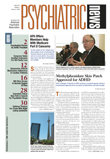“It seemed as if everybody who came into our clinic had migraines,” Catherine Mancini, M.D., recalled at the annual Canadian Psychiatric Association meeting in Vancouver. Mancini works at an anxiety disorders clinic at McMaster University in Hamilton, Ontario.
So Mancini and her colleagues conducted a study to find out exactly how many of their clinic patients really had migraines. They evaluated 206 consecutive patients psychiatrically, using a structured clinical interview. They also had the patients complete a self-report scale based on a headache diagnostic interview, using International Headache Society criteria.
Of the 206 patients, 67 percent met migraine criteria. The presence of major depressive disorder or dysthymia increased patients' risk of migraine 2.2 times. Thus, Mancini concluded, “Migraine headaches are highly prevalent in an anxiety disorders sample, particularly in those with comorbid major depressive disorder.”
Still stronger evidence linking migraines with major depression was reported in the November 2005 Canadian Journal of Psychiatry by Carmen Molgat, M.D., an assistant professor of psychiatry at the University of Saskatchewan in Saskatoon, Saskatchewan, and by Scott Patten, M.D., Ph.D., an associate professor of psychiatry at the University of Calgary in Calgary, Alberta.
Their study was based on a sample of more than 130,000 Canadians from the Canadian Community Health Survey, a cross-sectional survey conducted by Statistics Canada. The sample represented the Canadian population with the exception of military bases, First Nations reservations, and some remote areas in Quebec and Ontario.
The survey screened subjects for a broad range of medical conditions, including migraines and major depression, during the previous year. Major depression was evaluated with the Composite International Diagnostic Interview Short Form for Major Depression.
Clinicians are challenged to recognize that major depression and migraine coexist and to take this coexistence into account when developing treatment strategies.
The researchers then determined how many subjects in the entire sample had had an episode of major depression during the previous year, how many subjects who had had a chronic medical condition other than a migraine during the previous year had also experienced a major depression during that time, and how many subjects who had had a migraine during the previous year had experienced a major depression during that time.
The annual prevalence of major depression in the entire sample was 7 percent, and in subjects with chronic medical conditions other than migraines was 8 percent. In contrast, it was 18 percent in subjects reporting migraines.
Furthermore, after controlling for the effects of age and gender, subjects with migraines had a three times greater prevalence of major depression than those without migraines.
Thus, “there is a strong associated between major depression and migraine,” Molgat and Patten concluded in their study report, and“ the association between migraines and major depression differs from that of other chronic conditions....”
Also, they pointed out, their results have widespread public mental health implications since the annual prevalence of migraines in their study population was nearly 10 percent.
Although it is not clear whether migraines lead to depression or depression to migraines, the two illnesses may share certain biological causes, the researchers observed. There is evidence that both involve serotonin receptors and transporters, dopamine receptors, and adrenaline. Some studies also suggest that antidepressants can combat migraine and that the mainstream treatment of migraine—serotonin agonists—can decrease depression.
Regarding the practical implications of their findings, Molgat told Psychiatric News, “It is important for both psychiatrists and health care clinicians in a routine clinical setting to be aware of the high increased risk of a major depressive episode associated with migraine in all age groups. Clinicians are challenged to recognize that major depression and migraine coexist and to take this coexistence into account when developing treatment strategies. Possibly, more patients could benefit from a multidisciplinary intervention.”
“Comorbidity of Major Depression and Migraine—A Canadian Population-Based Study” is posted at<www.cpa-apc.org/Publications/CJP/current/cjp-nov-05-molgat-OR-nov.pdf>.▪
